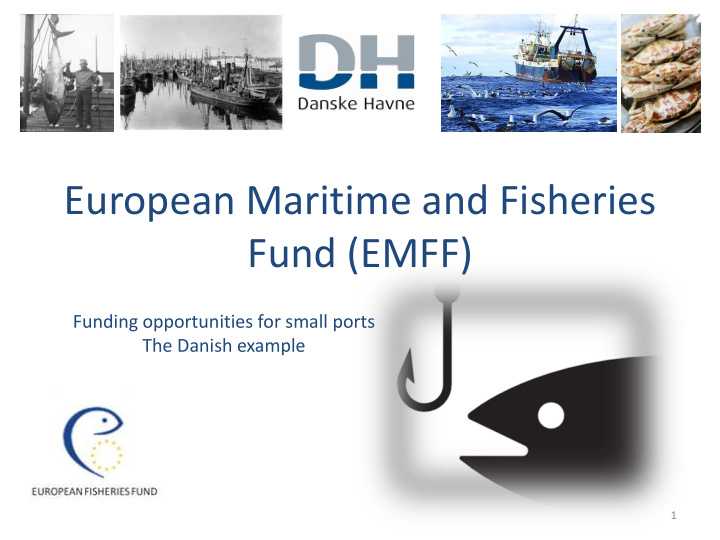



European Maritime and Fisheries Fund (EMFF) Funding opportunities for small ports The Danish example 1
Market trends • Volumes more than double size – 2003: Value of 1 ton industrial fish = 113 EU – 2015: Value of 1 ton industrial fish = 231 EUR – 2003: Value of 1 ton fish for consumer market = 840 EUR – 2015: Value of 1 ton fish for consumer market = 1.357 EUR – Total value of landed fish 2015 (250 ports) = 507 million EUR – Export value 2014 = 14 % of total food export = 2.7 billion EUR – 3.000 jobs in fisheries and 3.000 jobs in the fishing industry (2014) • Market consolidation in 5 ports: Skagen, Hanstholm, Thyborøn, Hirtshals og Hvide Sande – 90 % of the total volumes – 86 % of the total value • Active fleet is half the size over 10 years - larger vessels, larger volumes, larger investments the 32 largest vessels = 50 % of vessel capacity • Growth in foreign competition due to more consolidated fisheries market • Working environment is better due to safer facilities and access infrastructure • Fewer fishermen It is more attractive for each fisherman 2
Port role and value creation The port role • Full service and modern facilities create competitiveness • Infrastructure investment: Safe and easy accessible kays, efficient sorting, warehousing, auctions and distribution with focus on permanent cooling and water quality in the value chain • Themes for port investments: Access infrastructure , vessel service and optimisation of value chain The port value creation • Efficient unloading, processing, auction and unbroken cooling in value chain • Positive results of port investments in infrastructure: – Growth in value of fish due to internet auctions and unbroken cooling in value chain – Higher productivity, safer work environment due to efficient sorting facilities, covered facilities for fishing nets, tools etc. and calm port basins. – A service and supply improvement for the fishermen and vessels using the port, including better access to the port and full service – Attracting more fishermen due to a competence boost in the ports’ full -service solutions
The European Fisheries Fund • The program is influenced by national politics and political compromise strong political relations and a focus on the program process are necessary • Funding : 50 % financed by the port – 50 % financed by the EMFF – All other investment projects are financed by the state/EMFF – more flexibility for fishery ports when looking at utilising all grant funds towards the end of the program • Program 2007-2013: 24.5 million EUR • Program 2014-2017: 4.8 million EUR (coastal fishery, discard facilities and smaller investments in vessel service facilities • Program 2018-2020: Political negotiation ultimo 2017 – a large need for larger access infrastructure investments and supply chain optimisation aiming at 25-35 million EUR to boost full service model
Full service fishery ports • Investment focus: Full service ports – Unbroken cooling in value chain – Efficient auctions – Vessel service and raw material supply for local industry – Higher productivity through efficient facilities and infrastructure – Safety and working environment • Examples – port investments 2007-2014: Vessel service Value chain Access infrastructure • • • Vessel elevator Fish storage Piers and jetties • Vessel ramps and slipway • Ice plant • Kays • Loading/unloading • Cold storage • Weight securing kays • • • Electricity and water Crate washing Water depth • • • Fuel storage Crate storage Access ways • • • Environmental mgmt Sorting facilities Dredging • • Service facilities Multi purpose facilities • Dry tool facilities
SWOT example Helpful to achieving the objective Harmful to achieving the objective Internal STRENGTHS WEAKNESSES • • origin – Consolidation of the market to gain Lack of infrastructure in smaller ports – less attributes of economies of scale in big fishery ports efficient handling of fish • • the Full-service model in big ports Geografical placing of auctions (west coast) • • organisation Good working conditions Lack of other economic activity aside from • The port role as a motor for growth fishery (smaller ports) • • DK monopoly in EU on industrial fishery Old industry ruins • 344 delivery ports secures industry supply External OPPORTUNITIES THREATS • • origin – Bicatch, discard and new species Falling prises • • attributes of National strategy for industrial fishery Growth in foreign competition • • the Coastal tourism Political focus on small scale fishery • • environment Cluster development and port cooperation Environmental and habitat policies • • Fishery auctions and cooperation on quality Brexit – effects on common fisheries policy • Frozen fish (speed freezing) and fisheries trade • • Waste management and reuse Generational changes • Attraction of foreign vessels • Focus on value chain cooperation 6
Thank you for your attention Bjarne Løf Henriksen Commercial and Political Adviser Danish Ports Association blh@danskehavne.dk +45 2116 4045
Recommend
More recommend